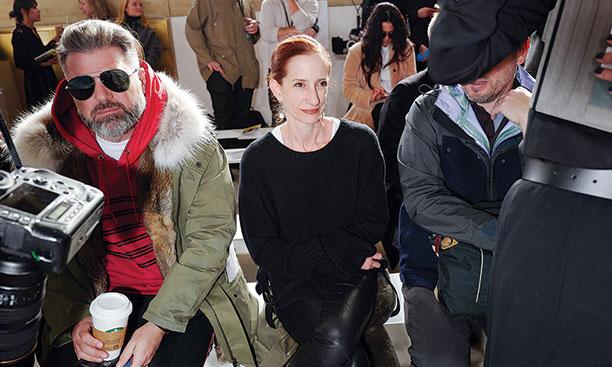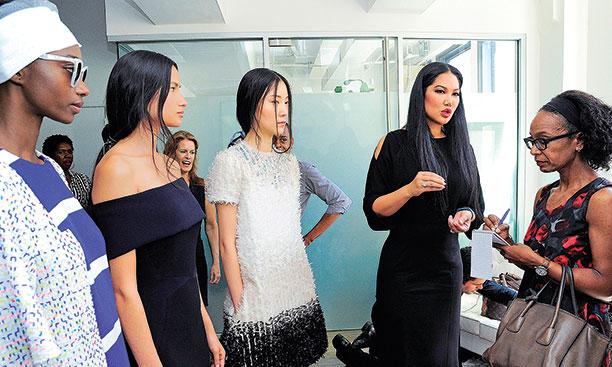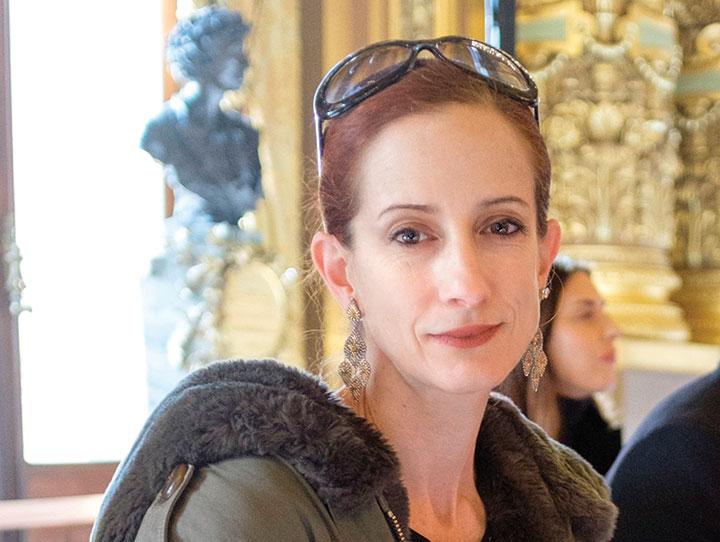First ladies are often seen more than heard. On many occasions — be it a visit to the troops or a White House appearance with a world leader — they stand wordlessly by the president’s side. Their clothes provide insight into their personalities and priorities.
From Mamie to Melania, the press has dissected and critiqued the first lady’s fashion. Barbara Bush’s style was called “part uppercrust matron, part favorite grandmother.” The 6-year-old dress that Rosalynn Carter wore to inaugural balls served as a symbol of the couple’s frugality but was lambasted as a missed opportunity to bring attention to a designer. Jackie Kennedy was lauded for using fashion to communicate a message about her husband’s presidency: It was modern and uniquely American.
So when Melania Trump wore a pair of black snakeskin stilettos to board Marine One for a visit to hurricane-ravaged Texas, the two Tigers who cover fashion for what are arguably the nation’s most influential newspapers weighed in.
Vanessa Friedman ’89, fashion director and chief fashion critic at The New York Times, wrote: “When is a shoe not just a shoe? When it is a pair of very high, needle-thin heels worn by the first lady of the United States on her way to the site of a natural disaster. Then it becomes a symbol for what many see as the disconnect between the Trump administration and reality; another example of the way in which this president and his family continue to define ‘appropriate’ their own way; and an excuse for partisan name-calling.”

Robin Givhan ’86, the fashion critic at The Washington Post, wrote: “It was also an image that suggested that Trump is the kind of woman who refuses to pretend that her feet will, at any point, ever be immersed in cold, muddy, bacteria-infested Texas water. She is the kind of woman who may listen empathetically to your pain, but she knows that you know that she is not going to experience it. So why pretend?”
The internet pounced on Stiletto-gate, with widespread critiques of Trump’s initial choice of footwear as out of touch (she changed into sneakers before landing in Texas). And then there was criticism of the criticism (“This is journalism?”). But clearly, readers were interested: Givhan’s story garnered more than 4,400 comments. Friedman’s was the most-read Times piece on the day it ran.
The attention, says Givhan, was warranted: “It’s very legitimate to write about it, because so much of what the first lady does is ceremonial. It’s performance, and part of that performance is the costuming.” A visit to the site of a disaster is designed to send a message: The president and first lady care. “It’s worth noting how you choose to costume yourself for that,” Givhan says.
Though their time at Princeton overlapped for a year, Givhan and Friedman didn’t meet until they were both on the fashion beat. They often find themselves sitting next to each other at runway shows. Today, their jobs involve scrutinizing public figures and a host of other issues raised by fashion as much as covering models on the runway. (For a school removed from the fashion center of New York, Princeton has had unusual success in preparing graduates to cover sartorial selections: Kate Betts ’86 — author of a book about the style of Michelle Obama ’85 — was the youngest editor-in-chief of Harper’s Bazaar, America’s oldest fashion magazine.)
“Everyone gets dressed in the morning, so everyone thinks about fashion,” says Friedman. A history major who credits Princeton for teaching her a critic’s essential skills — “how to think, how to research, and how to write and construct an argument” — Friedman got into the fashion field by accident: She wrote about the arts for Vogue and Elle, but an editor at the Financial Times, seeing those magazines on her résumé, assumed she was a fashion writer and assigned her a story about boots. In 2003, she became the Financial Times’ inaugural fashion editor. She joined The New York Times in 2014.
Givhan, an English major, first volunteered for the fashion beat as a 25-year-old reporter at the Detroit Free Press. She started covering fashion for the Post in 1995 and made history in 2006 when she became the first — and so far only — fashion critic to win a Pulitzer Prize, “for her witty, closely observed essays that transform fashion criticism into cultural criticism.” Givhan’s winning articles explored the clothing worn by political figures and celebrities; one story also analyzed how, in the movie Hotel Rwanda, the “rigidly professional attire” worn by the character of hotel manager Paul Rusesabagina as his country collapsed into genocide served as “complex visual markers of civility, order, and authority.”

“Fashion used to be thought of as a frivolous topic, but people now recognize that fashion is important on many levels — political and aesthetic. Fashion is part of society and history,” says Valerie Steele, the director of the Museum at the Fashion Institute of Technology. In a world where “we are inundated with visuals,” she says, “everyone is aware of branding. And politicians are essentially brands.”
“Just because something appears trivial does not mean it is any less powerful as a means of persuasion and outreach,” Friedman wrote in the Times in January 2017. “In some ways its very triviality — the fact that everyone could talk about it, dissect it, imitate it — makes fashion the most potentially viral item in the subliminal political toolbox.” She tells PAW, “People may be uncomfortable or insecure about judging tax policy or trade pacts, but everybody thinks they can judge clothing.”
As far back as Queen Elizabeth I, political figures have crafted their image to communicate with the public. The queen whitened her face and wore exaggerated ruffs to create a larger-than-life persona, Friedman points out. Five centuries later, newly elected youthful leaders adopt a modern look to put a fresh gloss on their governments.
Canada’s Justin Trudeau, France’s Emmanuel Macron, and 31-year-old Austrian chancellor Sebastian Kurz “crystallized the desire for change by connecting it to the look of generational change,” Friedman wrote in October. Kurz wears snug-fitting suits and often forgoes the obligatory tie in his very formal country to give the sense that he has transformed his party, the center-right People’s Party. He even changed the party’s official color from black to a cheery turquoise.
“That the newness seems to be in fact a swing to the right, and may involve a coalition with the far-right populist Freedom Party, has been made palatable by the artful way Mr. Kurz used his image to make the medicine go down,” she wrote. “It’s not the triumph of style over substance; it’s the use of style to convey, or sometimes camouflage, substance. And like it or not, it is increasingly looking like strategy.”
Many public figures try to use clothing to change the narrative. Appearing at a Pennsylvania courthouse to face arraignment on charges of sexual assault, comedian Bill Cosby didn’t wear a suit and tie, the customary attire for a court date. His “grandpa sweater,” as Givhan dubbed it in a 2016 story, with its “vaguely lopsided fit” and “toggle closures that might be found on a child’s coat,” had the look “of a sick-bed sweater. You could practically smell the Bengay.” The message, says Givhan: He was old and powerless.
Clothes can help a politician stand out in a crowded field — or bring unwanted attention. For men, slight variations on their widely accepted uniform can make huge ripples. When President Barack Obama departed from his usual gray or blue suit and wore a tan one for a 2014 press conference, Twitter surged with more than 4,000 tweets about the color choice while he was speaking. Several of the male candidates who hoped to succeed Obama shed their suits in favor of zip-collar sweaters when they had one-on-one contact with voters. “A cuddly fleece is supposed to make you look more engaging and approachable than a business suit,” observed Givhan. “They are all attempting to say essentially the same thing: I hear you; I understand you; I am like you. I would chop down trees for you.”
A number of world leaders — from the mayor of London to the president of China — have been gradually moving away from wearing ties, points out Friedman, with the goal of portraying themselves as more accessible politicians representing a new generation. But not President Donald Trump, who rarely departs from his formal starched shirts, French cuffs, and shiny, brightly colored ties. His attire is intended to hark back to the 1980s boom years, she wrote in the Times in May 2016: “He is emphatically and consciously not the new-look candidate. He is the old-look candidate.” Givhan agrees: “Trump does not roll up his sleeves. Are you surprised? No, of course you’re not.” His suits tell voters “he isn’t like you at all. ... Instead, he can fix you. He can fix America.”

Clothing choices are often trickier for women — but also potentially more potent because women have more sartorial options. Hillary Rodham Clinton was “trying to find a look that was the perfect balance of femininity and power and patriotism and accessibility. That’s a tall order for wool gabardine,” Givhan says. As first lady, clothing proved significant in an early critical moment: a press conference addressing a scandal regarding her profits in commodities trading. The event became known as “the pink press conference” because of the shade of her sweater.
That sweater was paired with a skirt, but by her 2000 campaign for Senate, Clinton was wearing pantsuits, a clothing choice now so associated with her that a Facebook group supporting her was called Pantsuit Nation. Her 2008 run for president was marked by the rainbow shades of those pantsuits — turquoise, canary yellow, tangerine. For her 2016 run, her first Instagram post showed pantsuits in red, white, and blue with the caption “Hard choices.” It was “brilliant,” Friedman says. Instead of complaining that scrutiny of her attire was sexist, “she owned it. The less women fight it, the more it becomes a tool to help women relate to them.”
READ MORE Fashion Critiques by Vanessa Friedman ’89 and Robin Givhan ’86
But her debate attire during the 2016 primary campaign led Friedman to write an article that ran under the headline “How Hillary Clinton Ended the Clothing Conversation.” Clinton’s pantsuits were now dark and bland — navy collarless suit, black pantsuit with black shirt, neutral coat jacket and khaki trousers — and took the subject of clothes off the table “by boring everyone into silence,” wrote Friedman, who thought that was too bad. They “say nothing about her tastes, her sense of humor, her idiosyncrasies. They do not humanize her. ... In sapping her clothes of potentially controversial content, Mrs. Clinton has also sapped them of personality.”
Clinton did embrace the symbolism of clothing at the most triumphant moment of her campaign: She accepted her party’s nomination in a white pantsuit, a tribute to the suffragists who fought for women to get the right to vote more than a century ago.
Michelle Obama ’85 — a first lady who spoke out in many ways — also embraced the opportunity her clothing choices offered and used it to powerful effect. “She was that rare first lady whose clothing seemed connected to the contemporary working woman,” Givhan says. Exhibit A: the J. Crew sweater, skirt, and top she wore on The Tonight Show with Jay Leno during her husband’s first presidential campaign. With a retail price of just more than $400, the choice conveyed accessibility. The ensemble was “a bridge between the White House and your house,” says Givhan. “You knew those clothes. Maybe you had those clothes.”
While she was in the White House, Obama’s fashion selections were made “extremely consciously and deliberately” to communicate the messages her husband’s administration wanted to get across, such as the importance of diversity, says Friedman. “She made something of an art out of pairing designers with countries during state dinners or trips.” At a state dinner honoring the prime minister of India, she would wear an Indian American designer, and so on.
Unlike most previous first ladies, who typically worked with one or two designers to create a wardrobe, Obama mixed high and low, including Talbots and Target. She wore outfits by several dozen designers over eight years, “which is impossible to do unless you are doing it on purpose. It was a clear effort to spread the wealth and use her position to elevate the name recognition of smaller designers,” Friedman says.
There is no indication so far that Melania Trump will follow suit in putting her clothes to work as assiduously as her predecessor. She sent a curious signal during the State of the Union address in January, when she wore a white pantsuit that seemed to echo Hillary Clinton’s. There was no way to know for sure, of course, whether she was providing a subtle clue to her emotions or had merely chosen the Christian Dior outfit because it looked good. Givhan writes that what this first lady wears is arguably more important than any other, since “she rarely speaks in public and has yet to make clear precisely what she might do with her time in the White House. ... The image becomes a silent expression of intent and self-awareness.”
In fact, many in attendance that night used their outfits as megaphones. (“The Capitol turned into an echo-chamber of ineffectual fashion Babel,” Givhan wrote.) Democratic female lawmakers wore black to salute the #MeToo movement. Members of the Congressional Black Caucus donned kente cloth over their shoulders to repudiate the president’s comments on Africa and Haiti. Republican women were urged to wear red, white, and blue to show patriotism.
Friedman took note: “The audience was theoretically supposed to be silent — the president was talking — but their clothes spoke for them.”
Jennifer Altmann is a freelance writer and editor.



